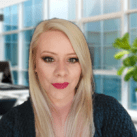
Your work beautifully intertwines beauty, embodiment, and sensory living. How did your personal journey lead you to this unique approach to spirituality and personal growth?
My personal journey began with a very religious upbringing. While I am no longer religious, I consider myself a deeply spiritual person. I believe that many people who come to embodiment—of any kind—often do so not purely out of passion or interest, but as a result of some sort of disconnection from the body. For me, a significant part of that disconnection stemmed from religion.
I remember being a little kid, making my first confession in the Catholic Church. When I entered the confessional, I didn’t really know what to confess. I simply looked back on all the times I had felt like I was being “bad.” Yet, as I reflected, I realized that the moments that came to mind—those I had been taught to feel guilty about—were the ones in which I felt the most joy. Like the time I did a cartwheel in the kitchen when I wasn’t supposed to. Or when I talked back to my grandmother in a moment of frustration. Essentially, any time I let my inner voice and natural desires guide me, I was led to believe I was sinning.
My personal journey has been a lifelong process of unraveling this conditioning—the idea that spirituality and personal growth are about striving for purity and perfection. Instead, I see them as a process of shedding the layers of conditioning that block our own authentic, simple radiance.
In the coaching industry, in particular, there is a strong emphasis on improvement. While self-improvement can be valuable—especially when we are struggling or lack basic life skills that weren’t passed down to us in childhood—what I have found, both in myself and in my clients, is that when we approach personal growth through the lens of constant improvement, there will always be something to “fix.”
This mindset is deeply influenced by the concept of original sin—a belief that we are inherently flawed and in need of correction. Not everyone has a religious upbringing, but we all exist within a culture shaped by Judeo-Christian values, which, in turn, influence our governments and institutions. As a result, we are all impacted by religious frameworks—particularly by patriarchal structures, which often seek power over others and attempt to confine God or spirit to institutions rather than recognizing the divine within our most tender, vulnerable inner voices.
For me, a profound shift occurred when I began to view personal growth through the lens of original blessing rather than original sin. The term original blessing, coined by theologian Matthew Fox, is based on the idea that we do not come from a place of inherent sin, subservience, or inferiority to God. Instead, we are radiant expressions of the divine.
This perspective is particularly important when it comes to our relationship with the body. At the core of personal growth, I believe what we are all truly seeking is an experience of self-trust. And for me—both personally and in my work with clients—self-trust begins with seeing the body as sacred and whole.
You emphasize the wisdom that speaks through the whispers of the body. Can you share a moment in your life when listening to these whispers changed everything for you?
That’s a great question. I would say there have been many moments in my life when I didn’t listen to these whispers. In fact, those moments were often more cataclysmic in connecting me to my intuition than the times when I did listen. It’s the times I ignored them that led me down roads of suffering, leaving me feeling disconnected from my own soul and wisdom.
Lately, I’ve been doing a lot of work to separate myself from the traditional eight-hour workday model. This is a simple example, but I’ve noticed a lingering sense of guilt and shame in my body. I work from home, I work for myself, and I have total freedom in creating my schedule. Yet, there remains an ingrained expectation that I should be working eight hours a day, that my workday should be highly structured with clear hours. I’ve run my business for twelve years, and so far, we are still thriving.
Recently, my spiritual practice has included a lot of two-way prayer, which involves writing to Spirit and asking, “What would you have me do today? How would you have me be today? What would you have me know today?” I ask for guidance, then allow Spirit to respond through my own pen in a stream-of-consciousness style. This practice has sharpened and refined my connection to my intuition.
As I move through my day, I connect with that inner voice—Spirit, abundance, love—the many names we use for the great mystery that pulses through our heartbeat and intuition. I ask, “What would you have me do in this moment?” What has truly changed everything for me is the way Spirit guides me to a level of self-care that I would have once deemed absurd. It’s not absurd to my heart and soul, but it feels absurd to the conditioned part of me that insists I should be at my desk, I should be working, I should be doing X, Y, and Z. Even on the weekends, that conditioned voice tells me I should be cleaning, reading, or accomplishing something.
We are plagued by these “shoulds,” especially in a capitalist society shaped by the Industrial Revolution—a time when human bodies were measured against machines. A big part of my work, beyond personal growth, involves understanding how cultural and societal influences contribute to a lack of confidence and disconnection from the body. These struggles are not just personal or familial; they are systemic.
Listening to these whispers has profoundly changed my workday. It has given me an abundance of energy—not just in the sense of having more stamina, but a deeper, creative energy that allows me to see things more clearly and make choices with greater impact. Rather than moving compulsively, just to stay busy, I act with intention. Interestingly, my work hours have decreased. When I tune in, Spirit often directs me toward self-care, a creative act, or time in nature. Ironically, this makes my work time far more efficient and productive.
That is one example of how these moments have changed my life.
What type of services do you offer?
One-on-one coaching is truly the heart of my business—it’s about personal relationships. But I also offer a membership program called The Sanctuary, a space designed to help individuals reconnect with a feminine approach to presence. I call it a feminine presence collective, where we practice the idea that presence is at the core of every desire.
In other words, whether we seek more money, time, love, or success, what we are truly longing for is the ability to appreciate life—to experience ease, freedom, and fulfillment. In my experience, both personally and professionally, this sense of fulfillment doesn’t necessarily come from acquiring more and more. Instead, it comes from learning how to be fully present with ourselves and the moment.
The Sanctuary is where we cultivate this feminine approach to presence. Unlike many spiritual and mindfulness traditions, which are largely based on a masculine framework, the feminine system regulates differently. While the masculine system often finds balance through solitary practice, stillness, and silence, the feminine system tends to regulate through sensory experiences that connect us to our bodies, through connection and resonance with others, through beauty, and through pleasure.
In The Sanctuary, we practice embodied experiences and practical tools for awakening more of that everyday magic—a deep, saturated sense of presence.
I also offer retreats, which are embodiment retreats. My podcast, Come to Your Senses, is a free space to explore living with more richness and radiance, and my retreats are an immersive extension of that philosophy.
In your experience as a Feminine Embodiment Coach, what are some common barriers people face in reconnecting with their bodies, and how do you help them soften into presence?
I’d say the most common barrier people face is the need for speed. The thing about embodiment—which is a word very present in the zeitgeist right now—is that, for me, both personally and in my work, it means being fully here, fully experiencing life and self, and expressing one’s needs and wants.
I often think about babies and young children and how naturally embodied they are. If they’re refused ice cream, they’ll wail in agony on the floor. But because they’ve fully discharged that strong emotion from their body, a minute later, they’re able to get up, play with their toys, and move on. As we grow older, however, culture, school, and work train us to ignore our body’s signals and rely primarily on logic and strategy.
So when people come to reconnect with their bodies, they often bring that same mindset—looking for a structured approach. They ask, How can I do this? What are the steps? What’s the formula? But softening into presence requires a different kind of intelligence, one that moves at the pace of genuine presence. It’s not necessarily slower; it’s just aligned with a different rhythm.
In embodiment and coaching sessions, we always start with a five-minute drop-in, where I guide clients through an embodiment process to quiet the noise of the strategizing, conquering mind and awaken a deeper wisdom—the stiller, quieter voice within. The session itself is a continuation of this process.
To come back to your question, softening into presence, for me, means moving at the pace of presence myself and acting as an anchor for my clients. It’s like being a divining rod or a lightning rod—not instructing them through a rigid three-step system, but modeling an embodied resonance they can attune to.
Embodiment moves deeper than language. We can talk about embodiment, somatics, and saturated presence, but it’s like swimming in the ocean—you can’t fully understand it until you experience it. The realm of embodiment is not about analyzing; it’s about feeling, sensing, and being.
Modern life often pulls people away from their senses and into their minds. What advice would you give to someone who wants to cultivate a more embodied and sensual way of living?
The guidance I would give to someone who wants to cultivate a more embodied and sensual way of living is to start simply. Sometimes, we think that in order to make a change in our lives, we have to take a wrecking ball to everything—tearing down existing structures and completely reinventing ourselves. But like you said, modern life moves fast. It pulls people away from their senses, instincts, and intuition, and into the conditioned, fearful mind.
That conditioned mind wants things now. It craves immediate change, mastery, and certainty as a strategy for safety. But true sensuality can be as simple as your next inhale and exhale. If you take a sip of water and really feel the temperature and texture of it as it moves through your body, you are already a radiant, sensual being.
You don’t have to be picking fresh blueberries on a summer day, wearing a white linen dress, to be embodied. Often, the images we associate with sensuality and embodiment actually distract us from the experience of them. Instead, practical ways to cultivate embodiment are rooted in using the senses to guide you.
For example, aroma—perhaps you keep essential oils at your desk and inhale lavender for calm. (Though I wouldn’t recommend peppermint near the eyes, just as a disclaimer!) Sight—you might bring a salt lamp into your bedroom, letting its soft golden glow embrace you as you wind down at night. Touch—maybe the next time you hug a loved one, you hold on just a little longer, allowing the warmth of that connection to truly land in your system.
Opportunities to connect sensually with life exist everywhere, in every moment. Cultivating that awareness is both an inner and outer art. The outer art might include filling your space with beauty—fresh flowers, soft lighting, rich textures. But the inner art is as simple as an inhale and an exhale. It’s looking into your beloved’s eyes as they speak, while simultaneously feeling your own body.
Right now, as I sit in my office, I notice a rainbow prism reflecting on the wall from something on my desk. These small moments of sensory awareness are available to us constantly—whether or not we’re wearing a linen pantsuit and a straw hat.
And finally, one of the most essential aspects of cultivating an embodied life is how we speak to ourselves. Embodiment and sensuality thrive in an environment of love, compassion, and acceptance—not in the pursuit of perfection.
Sometimes, we measure ourselves against impossible standards, asking, Am I embodied enough? Am I sensual enough? But the truth is, if you are breathing, if your heart is beating, if you are alive—then you are an embodied, sensual being. The question is simply: Where do you land in this moment on the spectrum of those things?



